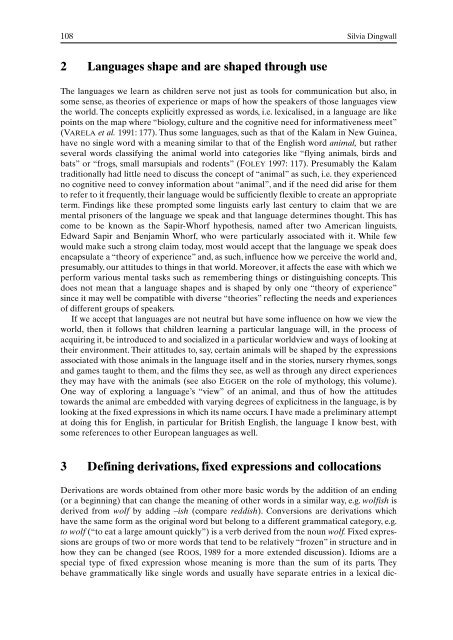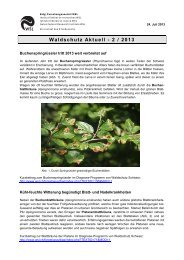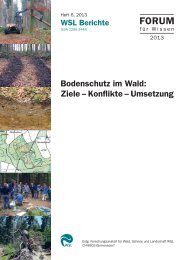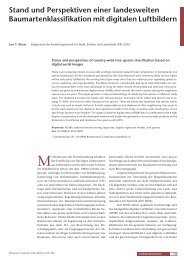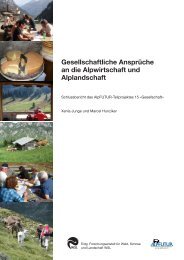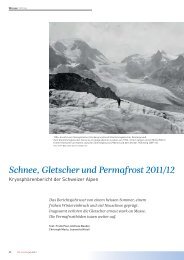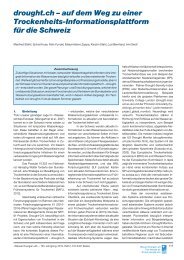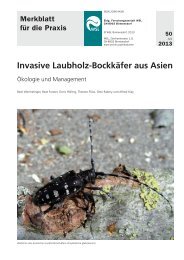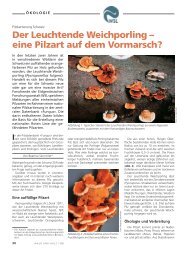Ravenous wolves and cuddly bears: predators in everyday ... - WSL
Ravenous wolves and cuddly bears: predators in everyday ... - WSL
Ravenous wolves and cuddly bears: predators in everyday ... - WSL
Create successful ePaper yourself
Turn your PDF publications into a flip-book with our unique Google optimized e-Paper software.
108 Silvia D<strong>in</strong>gwall<br />
2 Languages shape <strong>and</strong> are shaped through use<br />
The languages we learn as children serve not just as tools for communication but also, <strong>in</strong><br />
some sense, as theories of experience or maps of how the speakers of those languages view<br />
the world. The concepts explicitly expressed as words, i.e. lexicalised, <strong>in</strong> a language are like<br />
po<strong>in</strong>ts on the map where “biology, culture <strong>and</strong> the cognitive need for <strong>in</strong>formativeness meet”<br />
(VARELA et al. 1991: 177). Thus some languages, such as that of the Kalam <strong>in</strong> New Gu<strong>in</strong>ea,<br />
have no s<strong>in</strong>gle word with a mean<strong>in</strong>g similar to that of the English word animal, but rather<br />
several words classify<strong>in</strong>g the animal world <strong>in</strong>to categories like “fly<strong>in</strong>g animals, birds <strong>and</strong><br />
bats” or “frogs, small marsupials <strong>and</strong> rodents” (FOLEY 1997: 117). Presumably the Kalam<br />
traditionally had little need to discuss the concept of “animal” as such, i.e. they experienced<br />
no cognitive need to convey <strong>in</strong>formation about “animal”, <strong>and</strong> if the need did arise for them<br />
to refer to it frequently, their language would be sufficiently flexible to create an appropriate<br />
term. F<strong>in</strong>d<strong>in</strong>gs like these prompted some l<strong>in</strong>guists early last century to claim that we are<br />
mental prisoners of the language we speak <strong>and</strong> that language determ<strong>in</strong>es thought. This has<br />
come to be known as the Sapir-Whorf hypothesis, named after two American l<strong>in</strong>guists,<br />
Edward Sapir <strong>and</strong> Benjam<strong>in</strong> Whorf, who were particularly associated with it. While few<br />
would make such a strong claim today, most would accept that the language we speak does<br />
encapsulate a “theory of experience” <strong>and</strong>, as such, <strong>in</strong>fluence how we perceive the world <strong>and</strong>,<br />
presumably, our attitudes to th<strong>in</strong>gs <strong>in</strong> that world. Moreover, it affects the ease with which we<br />
perform various mental tasks such as remember<strong>in</strong>g th<strong>in</strong>gs or dist<strong>in</strong>guish<strong>in</strong>g concepts. This<br />
does not mean that a language shapes <strong>and</strong> is shaped by only one “theory of experience”<br />
s<strong>in</strong>ce it may well be compatible with diverse “theories” reflect<strong>in</strong>g the needs <strong>and</strong> experiences<br />
of different groups of speakers.<br />
If we accept that languages are not neutral but have some <strong>in</strong>fluence on how we view the<br />
world, then it follows that children learn<strong>in</strong>g a particular language will, <strong>in</strong> the process of<br />
acquir<strong>in</strong>g it, be <strong>in</strong>troduced to <strong>and</strong> socialized <strong>in</strong> a particular worldview <strong>and</strong> ways of look<strong>in</strong>g at<br />
their environment. Their attitudes to, say, certa<strong>in</strong> animals will be shaped by the expressions<br />
associated with those animals <strong>in</strong> the language itself <strong>and</strong> <strong>in</strong> the stories, nursery rhymes, songs<br />
<strong>and</strong> games taught to them, <strong>and</strong> the films they see, as well as through any direct experiences<br />
they may have with the animals (see also EGGER on the role of mythology, this volume).<br />
One way of explor<strong>in</strong>g a language’s “view” of an animal, <strong>and</strong> thus of how the attitudes<br />
towards the animal are embedded with vary<strong>in</strong>g degrees of explicitness <strong>in</strong> the language, is by<br />
look<strong>in</strong>g at the fixed expressions <strong>in</strong> which its name occurs. I have made a prelim<strong>in</strong>ary attempt<br />
at do<strong>in</strong>g this for English, <strong>in</strong> particular for British English, the language I know best, with<br />
some references to other European languages as well.<br />
3 Def<strong>in</strong><strong>in</strong>g derivations, fixed expressions <strong>and</strong> collocations<br />
Derivations are words obta<strong>in</strong>ed from other more basic words by the addition of an end<strong>in</strong>g<br />
(or a beg<strong>in</strong>n<strong>in</strong>g) that can change the mean<strong>in</strong>g of other words <strong>in</strong> a similar way, e.g. wolfish is<br />
derived from wolf by add<strong>in</strong>g –ish (compare reddish). Conversions are derivations which<br />
have the same form as the orig<strong>in</strong>al word but belong to a different grammatical category, e.g.<br />
to wolf (“to eat a large amount quickly”) is a verb derived from the noun wolf. Fixed expressions<br />
are groups of two or more words that tend to be relatively “frozen” <strong>in</strong> structure <strong>and</strong> <strong>in</strong><br />
how they can be changed (see ROOS, 1989 for a more extended discussion). Idioms are a<br />
special type of fixed expression whose mean<strong>in</strong>g is more than the sum of its parts. They<br />
behave grammatically like s<strong>in</strong>gle words <strong>and</strong> usually have separate entries <strong>in</strong> a lexical dic-


